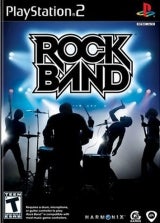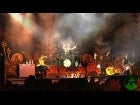GameSpy: To start, can you talk a bit about how the venues in Rock Band work? Do you unlock them sequentially, as in some of your previous games, or can you jump around to different venues at any time?
Pete MacDonald: It's much more organic and realistic than our previous games. You choose a starting city and you play a few gigs at a small club in that city until you earn a van. The van allows you to tour neighboring cities. After you've earned some fans locally you can play at larger venues in the local cites, then you earn a tour bus which unlocks other cites on the same continent. Later you get a plane which unlocks other continents and far-flung cities, but the whole time you keep unlocking gigs and venues in cities you've played before so you keep looping back and zig-zagging around, choosing between any number of available gigs.
Ryan Lesser: The vibe of the player's tour was meant to really mimic what it is like when you are in a band, trying to get more and more fans around the country or even world. A lot of us have been on tour with our bands and we wanted to get some of that feeling out there. One of the craziest parts of touring is "new day, new town."

One of Rock Band's new Chicago venues.
GameSpy: How many cities and venues are there?
Pete MacDonald: There are 41 venues spread across 17 cities. It's an amazing amount of work. I'm so proud of what this team has accomplished in less than a year.GameSpy: Are the venues based on real-world locations, completely fictional fabrications, or some combination of the two? What were the factors in deciding where to draw that line?
Pete MacDonald: Obviously, we started by looking at real-world venues for inspiration, but truthfully, most real-world venues look kind of the same on the inside. Or, more accurately: the sorts of things that are different between two venues, which you would notice as somebody at a show, don't really come across very clearly when the cameras are moving around and cutting really fast. So we needed strong visual hooks for each venue that are bolder than most real-world venues.
So even in places where we were strongly inspired by a real place, we amped up the decor of the stage and room so it could be noticed. For example, Bay City Theater in San Francisco started out being inspired by The Fillmore, but most of the beauty of the room itself didn't get any camera time in the game, so we latched onto the look of the psychedelic concert posters that you see at The Fillmore and made a stage that celebrates that.
Ryan Lesser: Yeah, we typically like to put some local "in" jokes into our games and Rock Band is no exception. As Pete said... the problem with really referencing a club that is out there is that a black room is a black room, y'know? Instead of just making the Bug Jar in Rochester or the old Providence club BabyHead, we used them as inspiration and put our own mark on them. It is also worth noting that we wanted to give the impression that these venues were in different parts of the world without being cheesy. We tried to avoid things like putting the venue in the Eiffel Tower and instead chose to do things like referencing art movements from the history of those cities... so that the club would feel like it was really built in that location at some point in time.





